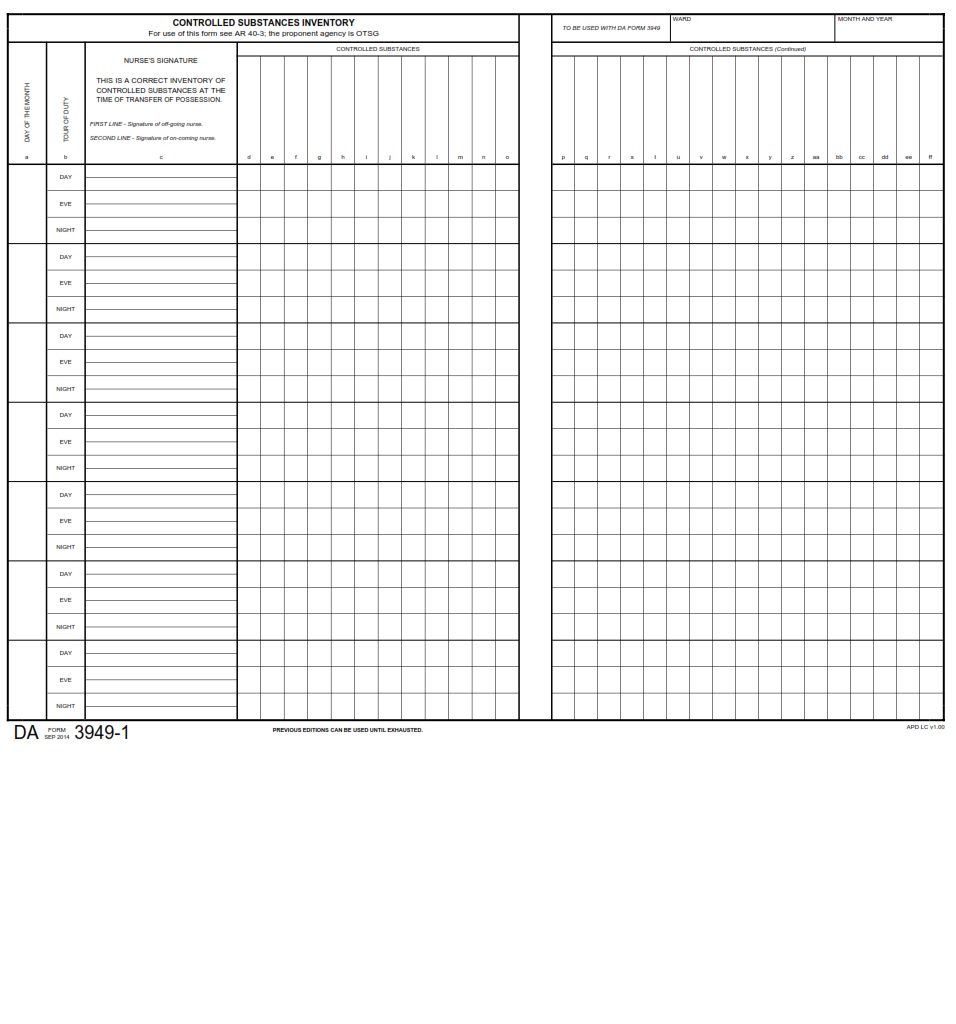Table of Contents
FREE-ONLINE-FORMS.COM – DA Form 3949-1 – Controlled Substances Inventory – Are you curious about what happens to controlled substances in the military? Have you ever wondered how inventory is managed and monitored to ensure security and accountability? Look no further than DA Form 3949-1 – the key document that tracks these valuable substances. In this article, we will delve into the world of controlled substances inventory and explore how this form plays a critical role in maintaining order and safety within military facilities. From prescription medications to illicit drugs obtained during operations, join us on a journey behind the scenes of this crucial aspect of military life.
Picture this: an underground vault filled with rows upon rows of locked cabinets, each containing powerful narcotics or sensitive compounds. It’s like a scene out of a high-stakes action movie, right? Well, believe it or not, this scenario is not just fiction; it’s an everyday reality in many military installations across the globe. The management and control of controlled substances are paramount for ensuring both safety and compliance with regulations. And at the heart of it all lies DA Form 3949-1 – a seemingly innocuous piece of paper that holds immense power in safeguarding these potent substances. Join us as we uncover the secrets hidden within this unassuming form and explore its role in protecting our armed forces from potential risks and dangers associated with controlled substances.
Download DA Form 3949-1 – Controlled Substances Inventory
| Form Number | DA Form 3949-1 |
| Form Title | Controlled Substances Inventory |
| Edition Date | 9/1/2014 |
| File Size | 130 KB |
What is a DA Form 3949-1?
A DA Form 3949-1, also known as a Controlled Substances Inventory, is a crucial document used by the U.S. Department of Defense (DoD) to track and monitor controlled substances within military facilities. This form plays an essential role in ensuring accountability and preventing misuse or diversion of these substances.
What sets the DA Form 3949-1 apart from other inventory documents is its thoroughness and attention to detail. It mandates that supervisors document each substance’s name, strength, dosage form, quantity on hand, balance unit price per dose/package, total value, reorder point level and much more. By meticulously recording these details and conducting regular inspections to reconcile discrepancies between inventory records and actual stock levels, military agencies can remain proactive in managing controlled substances.
Moreover, the DA Form 3949-1 enables commanders to identify trends or patterns in controlled substance usage and assess if any adjustments are necessary regarding procurement or allocation. The information collected through this form provides valuable insights into consumption rates among different units or departments within the military facility. With these fresh perspectives on drug usage patterns and trends at their disposal, leaders can make informed decisions about resource allocation while maintaining adequate control over potentially hazardous substances.
Where Can I Find a DA Form 3949-1?
If you’re looking for a DA Form 3949-1, you’ve come to the right place. This form, also known as a Controlled Substances Inventory, is an essential document for tracking and monitoring the use of controlled substances within an organization or institution. However, finding this form can be a challenge, especially if you’re not familiar with the military’s bureaucratic systems.
One of the easiest ways to find a DA Form 3949-1 is through online resources specifically designed for military personnel. Websites such as armyapd.army.mil or armyproperty.com provide a wide range of forms and templates that are easily downloadable and ready for use. Additionally, reaching out to your respective branch of service should provide guidance on how to obtain this form directly from military sources.
Another option is visiting your nearest Army Community Service (ACS) office or Military Police station. These offices often have copies of various forms readily available and can assist you in filling them out correctly. Furthermore, they may even provide additional guidance on proper inventory management practices when it comes to controlled substances.
In conclusion, finding a DA Form 3949-1 may seem challenging at first glance, but with the right resources and support from military entities such as online platforms or local offices like ACS or Military Police stations, obtaining this form becomes much easier. Remember that accurately completing this crucial document ensures efficient tracking and control over controlled substances within your organization – an essential practice in maintaining safety and legality surrounding these substances.
DA Form 3949-1 – Controlled Substances Inventory
When it comes to controlled substances, proper inventory management is crucial in maintaining accountability and preventing potential misuse or diversion. The DA Form 3949-1, also known as the Controlled Substances Inventory, serves as a valuable tool for healthcare facilities and pharmacies to track and monitor these substances. It not only aids in complying with legal requirements but also helps ensure patient safety.
One key aspect of the DA Form 3949-1 is the detailed documentation it provides for each controlled substance. This includes information such as the drug’s name, strength, dosage form, quantity on hand, lot number, expiration date, and manufacturer details. This level of specificity enables healthcare professionals to easily verify the accuracy of their inventory and identify any discrepancies that may require further investigation.
By regularly conducting controlled substances inventories using the DA Form 3949-1, healthcare facilities can detect potential issues early on. For example, if there are significant discrepancies between what is recorded on paper versus what is physically present in stock, it could indicate possible theft or improper handling of medications. Detecting such problems promptly allows organizations to take appropriate measures to address them before they escalate into more significant issues or harm patients.
